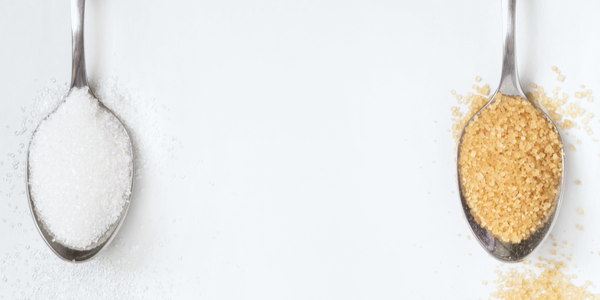
Though the body essentially treats refined sugars in the same fashion, each sugar type has its own set of characteristics and features. All sugars bring their own appearance, texture, and taste which is why certain recipes call for specific types of sugar. White and brown sugar are the most commonly used and called for sugars in recipes.
How is brown sugar different from white sugar besides just appearance? What recipes are better for white or brown sugar?
Read more to discover the differences, similarities, and uses for white and brown sugar.
Granulated (White) Sugar
Granulated sugar is the sugar commonly recognized as "white" or "table" sugar and vastly used in commercial products and recipes. It is almost completely sucrose, a natural sugar occurring in sugar cane and beets, and processed down to a salt-like texture.
Granulated sugar crystals do not usually clump together, making them ideal for dissolving readily in liquids to add a smooth sweetness. White granulated sugar can also provide a moist texture for baked goods, add color, and enhance flavor to foods.
Granulated Sugar Nutrition
White sugar does not have a complicated nutrition profile. It only provides carbohydrates and is devoid of fat, protein, vitamins, or minerals. This is the main reason why sugar gets a bad rep nutritionally and is referred to as empty calories.
A teaspoon of white sugar provides 16 calories from 4 grams of carbohydrates. White sugar gets readily absorbed into the bloodstream after eating which is a main reason it is recommended to limit intake.
Brown Sugar
Brown sugar is very similar to white sugar in taste, nutrition, and applications. Brown sugar is made by combining white sugar with either molasses or made by boiling a brown sugar syrup, according to The Sugar Association.
Because this process adds a liquid to the sugar, brown sugar is more moist than white sugar which can lead to clumping or hardening. This also gives brown sugar more of a caramel-like or molasses flavor compared to white sugar. This adds a benefit when used in certain baked goods, as it helps provide a chewier texture.
Light vs Dark Brown Sugar
A further differentiation for brown sugar is light vs dark brown. In general, light brown sugar is more widely used for baking and most home cooking recipes. Dark brown sugar has a deeper molasses-like flavor compared to light brown sugar and is used more for gingerbread, baked beans or barbecue sauce.
If a recipe calls for dark brown sugar, but there is only light brown sugar in the pantry, light brown sugar could be used as a substitute. The deep molasses-like flavor will be slightly lighter, but most will probably not even notice.
Brown Sugar Nutrition
Brown sugar nutrition is basically the same as white sugar. A teaspoon of brown sugar provides only carbohydrates and lacks fat, protein, vitamins, or minerals. As with white sugar, brown sugar is readily absorbed into the bloodstream after eating.
A teaspoon of brown sugar provides 17 calories from 4.5 grams of carbohydrates. Brown sugar can provide slightly more carbohydrates and calories depending on how much is packed into a teaspoon. A difference from white sugar is brown sugar can be packed in or loosely measured out.
There may be slight nutritional differences brought on by the molasses content of brown sugar, as it may provide trace amounts of minerals. So when it truly comes down to the question, "Is brown sugar healthier?" It is essential to remember sugar is sugar, mostly lacking in nutrients while adding calories.
The American Heart Association recommends that added sugar (of all kinds) be limited to no more than six teaspoons (for women) and nine (for men) teaspoons each day.
Conclusion: Brown Sugar vs White Sugar
The core similarities between brown and white sugar include:
• Provides about 4 grams of sugar per teaspoon
• Made up of carbohydrates only
• Easily absorbed into the bloodstream
• Used for baking
• Made from sugar cane or sugar beets
• Considered a source of added sugar that should be limited in the diet
The dominating differences between brown and white sugar include:
• Brown sugar has molasses or other boiled down liquid added to white sugar.
• Because a liquid is added to brown sugar, it is more likely to clump or become hard.
• Brown sugar is usually used in baked goods, as it can help provide a chewy texture.
• Dark brown sugar can be used for foods that have a deeper flavor of molasses-like gingerbread, barbecue, or baked beans. Light brown sugar is usually used for baking. Granulated sugar can be used for baking but also for sweetening drinks or many other foods.
• Brown sugar may provide trace amounts of minerals from the molasses, but it is not considered a good source of nutrients.
Whether using light and dark brown sugar or refined white sugar, keep in mind recommended intakes. While sugar can certainly be enjoyed and relished, too much can negatively impact health.
Reference:
Types of Sugar. The Sugar Association. Published February 3, 2021. https://www.sugar.org/sugar/types/.







